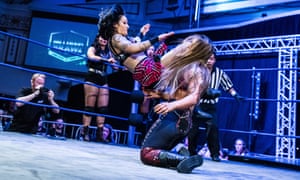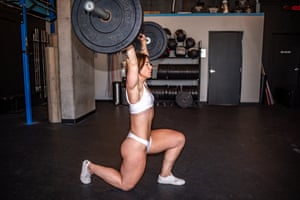A woman in activewear crosses the street towards a car with blacked-out windows and no licence plates and says to the man inside, “Did you just catcall me?”
When he reluctantly confirms that he did, she says cheerfully, “I’m just going to tell you right now, a lot of women get intimidated when you do that … Most women are like, this motherfucker’s going to throw me in the back of the car, you know what I mean? I dress like this because it’s hot as fuck and I work out really hard. Pow. I’m strong and powerful and I’d fuck you up. But what I’m saying is, a lot of women get really intimidated by catcalling. You got me? So that’s what’s up. What’s your name?”
She fist-bumps him. “Jason, I’m Kortney. It’s nice to meet you. Take care.”
Jason likely didn’t know he’d chosen Kortney Olson to hiss at. She’s the bodybuilder who smashes watermelons between her thighs and is an Australian women’s armwrestling champion. Her Instagram page is full of powerlifting feats – and the occasional candid video like her meeting with Jason.
Olson benchpresses men like Jason.
Go into any gym these days and you’ll notice a migration of women from treadmills and cardio classes to the weights section. Back gains and abs are the new aesthetic, thanks in part to the rise of CrossFit, Bodypump and F45, and gym noticeboards are more concerned with strength competitions – heaviest leg press, squat etc – than scale measurements. Mega-ripped fitness models such as Gracyanne Barbosa have millions following their workouts on Instagram, and the US-founded STRONG Fitness Magazine launches in Australia this month, aimed at women.
“I love muscle. That’s just my thing,” says Olson, whose website delivers training programs that promise to add an inch to arms and legs: “Not so much on dudes – it’s not a prerequisite – but on women it’s outstanding.”
Olson was fascinated by the idea of having a six-pack from an early age, partly from idolising her older brother and partly, she says, because she was molested as a seven-year-old.
“From that point on, I created this image of myself being ripped in order to feel protected and worthy and safe,” she says. “I have found that most of the women that get into bodybuilding or strength training or powerlifting have had some kind of trauma.”
But there’s also that cultural swing. Kettlebell athlete Eilish Kidd competes on an international level, performing competition lifts such as the snatch, jerk and the long cycle over as many reps as possible in 10 minutes. She’s noticed that while bigger glutes are still a priority for many women, so too is all-over muscle as an aesthetic.
When Kidd first started working out in her 20s, she was too ashamed to let her boozy art school mates know about this extracurricular activity and would sneak off to train with a female bodybuilder she’d met. The boutique Hobart gym, Artgym, that she went on to open has a 1980s Memphis look and aims to attract those who are put off by corporate environments.
Kidd was drawn to kettlebell as it’s the ideal sport for introverts. She started late, in her mid-30s, but age wasn’t as significant a number to her as the reps or kilos. Her weekly regime now involves two kettlebell training sessions, a mobility session, a light Olympic weightlifting session, a strength-conditioning session, and some cardio.
“Kettlebell is really technical, so you build up all of these elements and then when they all come together you feel powerful,” she says. “It’s a feeling of happiness, even when it’s painful.”
Kellyanne Salter’s idea of happiness comes from finishing off opponents with a cannonball or a missile dropkick. The Melbourne pro-wrestler says she’s never wanted to be skinny. “Obviously I have to look aesthetically pleasing so I watch what I eat,” she says. “But I’m always trying to increase my strength.”
From the age of eight, Salter idolised the pro-wrestler Lita. In an era when female wrestlers tended to be cheerleader types, Lita was strong, tattooed and had the technical skills.
“All I wanted to do was wrestle and I didn’t care about how I looked, but all the female wrestlers on TV were eye candy,” says Salter, who lied about her age when asking to join a local promotion and started training at 14. “That led me to believe at that age that I had to get a boob job.”
Salter fobbed off that idea but she reckons having her distinctive look has held her back from a career with WWE, for whom she had a tryout in 2016. “They want blank canvases so they’re not able to mould me,” she says. Instead she saves her money and spends stints wrestling in Mexico, Europe and the US. She frequently takes part in intergender matches and can’t understand resistance to the idea of women fighting men.

“I was usually the only girl at training, so it was normal for me to wrestle men,” she says.
Now Salter trains in the gym four days a week, isolating body parts – back, legs, arms. Another day she’ll train in the ring and she’ll usually wrestle for real on a Saturday night. She’s the current impact pro-wrestling New Zealand women’s champion, and on October 11-12 she’ll compete in a Melbourne city wrestling invitational tournament that will result in the promotion’s first women’s champion being crowned.
Some men are threatened by strong women, as one marine found out when she tweeted a video of herself doing squats with a man in a firefighter’s lift across her shoulders.
Dani
(@dani_g_3)When I was 12, I remember my friends stepdad (who was a firefighter) comment on how he felt women didn’t belong in the fire department because “no girl could ever lift a grown man” lol anyways, fuck you Craig. pic.twitter.com/C4dU0MOtW5
The video got 10.2m views and plenty of butt-hurt comments. But for others, female strength is a fetish.
Salter gets lots of DMs from men offering her big bucks to crush them with her thighs, or for her used gear. Heads up: it’s not going to happen. “I’ve actually seen some of my wrestling matches uploaded on to Pornhub, with people time-stamping when my legs are open,” she says. “I choose not to get offended by it.”
Olson knows all about that. A few years back she made headlines when Australian tabloids uncovered her “porn” past, which was actually clothed videos of her crushing men, or of them worshipping her calves. “I don’t like to hurt people,” she says. “But I can. It’s more about them experiencing true female strength, and that’s breaking the societal norm.”
The tabloid interest arose because Olson is married to David May, who was chief executive of the Gold Coast Titans at the time. She also volunteered as the Titans’ under-20s strength and conditioning coach. As far away as England there were headlines such as “Ex-porn star helps with ‘cor’ strength”.
It got her down for a while, particularly because she had applied to be a mentor for young women and didn’t get that gig as a result of the media attention. Instead she wrote a program for marginalised teenagers, Kamp Konfidence, and ran it in the Gold Coast hinterland. When that became too unwieldy, she set up activewear brand GRRRL Clothing and runs it with a team of five from her new base of Las Vegas.

Taking a gamble, she dumped traditional sizing in favour of GRRRL sizing – customers pick one of eight athletes who have vastly different body shapes by comparing their own measurements. Once you work out who you’re closest in shape to, say, world record-holding powerlifter Amenah Razeghi, or UFC women’s strawweight champion Zhang Weili, you order your clothes under their names rather than by size.
GRRRL has also partnered with the National Eating Disorders Association in the US. While Olson got a grip on her drug addiction years back, getting a healthy relationship with food took longer – a problem that many people who train regularly will be familiar with.
“In the not so distant past I was doing CrossFit, Brazilian jiu jitsu and Bikram yoga all in the same day, five days a week,” she says. She’s since had her breast implants removed and posts unfiltered videos of her struggles with body image, even as someone revered for her strength.
“We’ve still got a lot of programming to undo,” she says.
Source: TheGuardian
